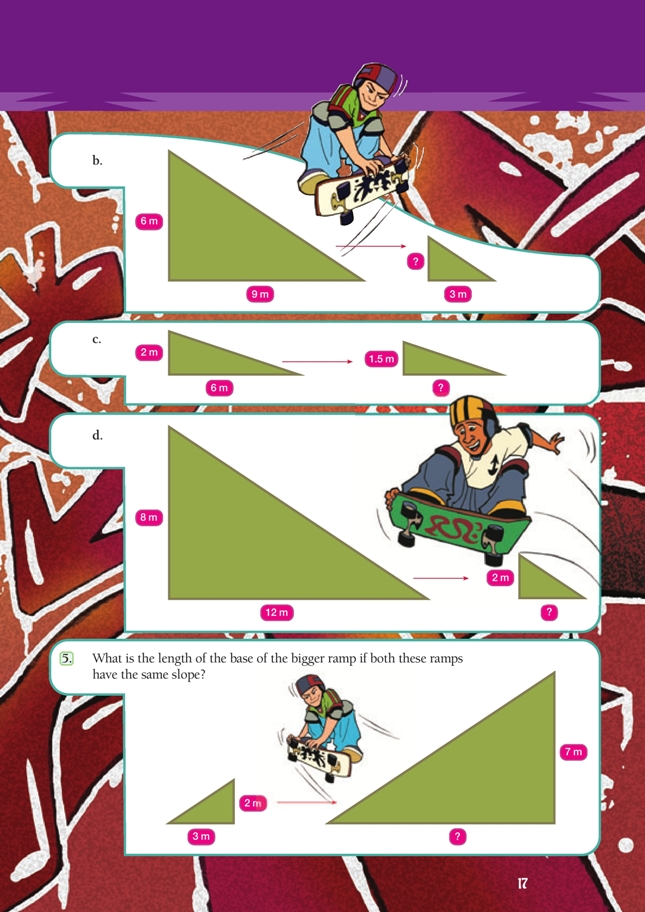This is a level 5 number activity from the Figure It Out series. It relates to Stage 8 of the Number Framework.
A PDF of the student activity is included.
Click on the image to enlarge it. Click again to close. Download PDF (926 KB)
use ratios to describe slopes
Number Framework Links
Use this activity to:
• help students consolidate and apply their knowledge of equivalent fractions (stage 7)
• encourage the transition from advanced multiplicative strategies (stage 7) to advanced proportional strategies (stage 8).
A calculator
This activity explores the base–height–slope relationship and introduces students to similar triangles. Similar triangles are a further application of direct proportion. It’s a good idea to introduce the activity using materials. Rulers (30 cm and 1 m) and cubes (1 cm and 2 cm) are useful:
Put the students into problem-solving groups. Tell them to represent the ramp with a ruler. Get them to keep its lower end 24 cm from the base of the pile of cubes and to explore what happens to its slope when its height is changed by adding or removing cubes.
Next they should leave their pile of 4 cubes in place but move the lower end of the ramp along the horizontal ruler and note what happens to the slope. They should then change both the number of cubes and the position of the bottom of the ramp and note how the slope changes.
Have the students set up two ramps. The first is their benchmark ramp. Working now with the second ramp, challenge the students to change both the height and the position of the lower end whilst keeping the slope the same as that of the benchmark ramp. They should see that there is a precise relationship between height, base, and slope, even if they can’t put it into words yet.
Ask the students to solve questions 1 and 2 in their small groups and report back with their answers for question 2b. Help them refine their statements into a formula. Two alternatives are:
• height of ramp = length of base divided by 3 (h = b/3)
• the base is 3 times as long as the height (b = 3 x h).
Some may like to express the slope as a ratio, 1:3.
(Note that when expressing slope as a ratio, height always comes before base. This convention avoids confusion. Walking up a 1:5 slope is altogether different from walking up a 5:1 slope!)
Your students should now be able to solve question 3.
When solving questions 4 and 5, your students may find that a ratio table or double number line helps them to see how the height and base are related:
They can then use multiplication or division to find the missing dimensions. Another important insight is that the height–base relationship for any slope can be seen as an (infinite) sequence of equivalent fractions, for example: 2/3 = 4/6 = 6/9. Students can use this insight as a strategy for solving these problems.
As an extension, this activity could be used to introduce the concept of similar triangles (and other similar shapes). There are two key ideas to get across:
• In maths, similar means “has exactly the same shape as”.
• Each pair of corresponding (matching) sides is in the same ratio.
Using the two triangles shown as an example, base 1 : base 2 = height 1 : height 2
= slope 1 : slope 2.
You could challenge your students to identify which of the four pairs of triangles in question 4 are similar. (Pairs a, b, and d are because the height:base ratio in each case is 2:3.)
Answers to Activity
1. Answers will vary, but the base must be less than 12 m in each case. Three possible answers (using only whole numbers) are: base 9 m, height 3 m; base 6 m, height 2 m; base 3 m, height 1 m.
2. a. There are an infinite (endless) number of possible ramps with the same slope.
b. To have the same slope, the height must always be one third of the base.
3. a. 5 m
b. 7 m
4. a. 2 m
b. 2 m
c. 4.5 m
d. 3 m
5. 10 1/2 or 10.5 m. (The base of the small ramp is 1 times its height, so the base of the larger ramp will be 1 1/2times its height. 1 1/2 x 7 = 10 1/2m.)




